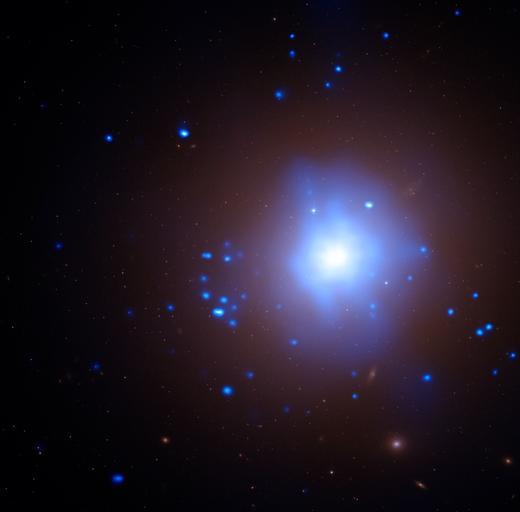MAKE A MEME
View Large Image

| View Original: | Massive_Black_Hole_Implicated_in_Stellar_Destruction_-_An_elliptical_galaxy_in_the_Fornax_cluster_that_contains_an_ultraluminous_X-ray_source..jpg (3600x3547) | |||
| Download: | Original | Medium | Small | Thumb |
| Courtesy of: | www.flickr.com | More Like This | ||
| Keywords: smithsonian institution smithsonianinstitution black hole blackhole smithsonian astrophysical observatory smithsonianastrophysicalobservatory outdoor Description: X-rays from Chandra and optical spectra from the Magellan telescopes provide evidence that a star was destroyed a black hole in a globular cluster. The Chandra data (blue) reveal a so-called ultraluminous X-ray source. When combined with optical observations, it suggests that a white dwarf star strayed too close to an intermediate-mass black hole and was ripped apart by tidal forces. If confirmed, this would be the first substantiation that globular clusters contain this middle-sized class of black hole. Creator/Photographer: Chandra X-ray Observatory NASA's Chandra X-ray Observatory, which was launched and deployed by Space Shuttle Columbia on July 23, 1999, is the most sophisticated X-ray observatory built to date. The mirrors on Chandra are the largest, most precisely shaped and aligned, and smoothest mirrors ever constructed. Chandra is helping scientists better understand the hot, turbulent regions of space and answer fundamental questions about origin, evolution, and destiny of the Universe. The images Chandra makes are twenty-five times sharper than the best previous X-ray telescope. NASA's Marshall Space Flight Center in Huntsville, Ala., manages the Chandra program for NASA's Science Mission Directorate in Washington. The Smithsonian Astrophysical Observatory controls Chandra science and flight operations from the Chandra X-ray Center in Cambridge, Massachusetts. Medium: Chandra telescope x-ray Date: 2010 Persistent URL: chandra.harvard.edu/photo/2010/ngc1399/ Repository: Smithsonian Astrophysical Observatory Gift line: X-ray: NASA/CXC/UA/J. Irwin et al; Optical: NASA/STScI Accession number: ngc1399_443 Description: X-rays from Chandra and optical spectra from the Magellan telescopes provide evidence that a star was destroyed a black hole in a globular cluster. The Chandra data (blue) reveal a so-called ultraluminous X-ray source. When combined with optical observations, it suggests that a white dwarf star strayed too close to an intermediate-mass black hole and was ripped apart by tidal forces. If confirmed, this would be the first substantiation that globular clusters contain this middle-sized class of black hole. Creator/Photographer: Chandra X-ray Observatory NASA's Chandra X-ray Observatory, which was launched and deployed by Space Shuttle Columbia on July 23, 1999, is the most sophisticated X-ray observatory built to date. The mirrors on Chandra are the largest, most precisely shaped and aligned, and smoothest mirrors ever constructed. Chandra is helping scientists better understand the hot, turbulent regions of space and answer fundamental questions about origin, evolution, and destiny of the Universe. The images Chandra makes are twenty-five times sharper than the best previous X-ray telescope. NASA's Marshall Space Flight Center in Huntsville, Ala., manages the Chandra program for NASA's Science Mission Directorate in Washington. The Smithsonian Astrophysical Observatory controls Chandra science and flight operations from the Chandra X-ray Center in Cambridge, Massachusetts. Medium: Chandra telescope x-ray Date: 2010 Persistent URL: chandra.harvard.edu/photo/2010/ngc1399/ Repository: Smithsonian Astrophysical Observatory Gift line: X-ray: NASA/CXC/UA/J. Irwin et al; Optical: NASA/STScI Accession number: ngc1399_443 | ||||